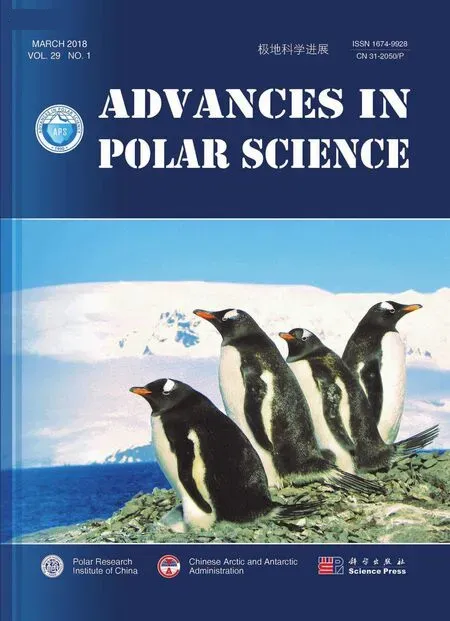Polar science needs a foundation: where is the research into polar infrastructure?
2018-12-31AdrianMCCALLUM
Adrian MCCALLUM
Faculty of Science, Health, Education and Engineering, University of the Sunshine Coast, Sippy Downs Drive,Maroochydore, Queensland 4558, Australia
Keywords polar infrastructure, operations, technology
As the world continues to grapple with an evolving climate,science across the atmospheres, oceans and ice sheets of our polar regions remains increasingly important. However, the conduct of polar science relies upon polar infrastructure and whilst some facets of polar science receive significant funding, research into polar infrastructure is lacking.*
The International Polar Year 2007–2008 provided the impetus for numerous nations, particularly some of those that are members of the Asian Forum for Polar Sciences(AFoPS), to increase their polar science capability and development of new infrastructure (Krupnik et al., 2011;Allison et al., 2008). There are numerous examples of recent innovative design of new Antarctic stations:Belgian’s Princess Elisabeth Station, South Korea’s Jang Bogo Station in Terra Nova Bay and China’s 5th Antarctic research station, currently being constructed on Inexpressible Island. Further, many nations including Australia, China, Korea, France, Japan and South Africa have recently built, or are building, new Antarctic research and support vessels.
However, numerous states are only belatedly recognizing that infrastructural limitations are compromising their polar scientific capability. In 2012, the US released an examination of its need to renew its infrastructure and logistical capability in Antarctica (US Antarctic Program, 2012) and in 2016, the Australian Antarctic Division released its own Australian Antarctic Strategy and 20 Year Action Plan (Australian Antarctic Division, 2016).
The Australian documents explain Australia’s future role in Antarctica and outlines the measures needed to be implemented to retain the nation’s role as a leader in Antarctic science. At the time of writing, Australia has commissioned a new icebreaker and is recruiting personnel to manage the establishment of an overland traverse capability, station upgrades and improved year-round aviation links.
So, importantly, reassessment of infrastructural needs is occurring, but, research into the optimal development or utilization of these science-enablers appears to remain lacking.
The US Army established its Snow, Ice and Permafrost Research Establishment (SIPRE) in 1949. This institution evolved into the US Army Cold Regions Research and Engineering Laboratory (CRREL) in 1961,as Cold War tensions increased and troop-mobilization across the polar regions became ever-more important.CRREL and similar organizations in the USSR and elsewhere made significant advances in fields such as snow mechanics and cold region terrain/vehicle interaction.However, as Cold War tensions eased and the polar regions became increasingly devoted to science, the level of scientific endeavor increased, but the level of commensurate research into the provision of suitable polar infrastructure and operational techniques did not.
CRREL has made recent contemporary advances, with the introduction of poly-sled and flubber technology,enabling the provision of an efficient over-snow refueling capability to the South Pole, and other nations such as the UK and Australia have also adopted this technology. But,the lack of a wheeled runway at the South Pole in support of the USAP, the last great polar infrastructural problem,perhaps best exemplifies that as far as the author is aware,insufficient support continues to be available for the necessary research into the ongoing viability of such a runway and similar science-enabling infrastructure.
As an example, White and McCallum (2017) recently published a review of ice and snow runway pavements in which they identified the gap that exists between the design of contemporary asphalt pavements and their polar equivalents. Much work was done through the 1950s, 1960s and into the 1980s, but limited resources have been devoted to the advancement of these fields in the last twenty years and no significant progress has been made into snow/ice runway design in recent decades.
The pursuit of science bounds ahead in the polar regions; but, are we investing sufficiently in parallel research that will support the use of innovative technologies to develop contemporary infrastructure and operational techniques that can best support this science into the future?
Note:Queries and discussions on this article should be made by E-mail directly with the corresponding author.
杂志排行
Advances in Polar Science的其它文章
- Influence of the Agreement on Enhancing International Arctic Scientific Cooperation on the approach of non-Arctic states to Arctic scientific activities
- The post-Paris approach to mitigating Arctic warming—perspectives from shipping emissions reduction
- Aspect sensitivity of polar mesosphere summer echoes observed with the EISCAT VHF radar
- Occurrence of seabirds and marine mammals in the pelagic zone of the Patagonian Sea and north of the South Orkney Islands
- Glacier systems response on climate change by the definite climatic scenario: northeast Russia
- Arctic warming and its influence on East Asian winter cold events: a brief recap
